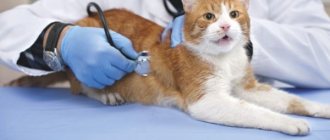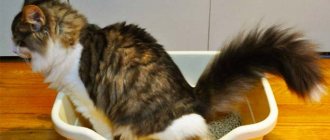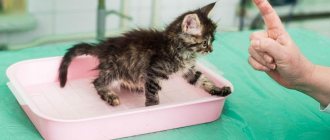4862Administration
The bladder of all living beings is a unique organ, which is striking in its elasticity and is second only to the uterus in its ability to stretch. Every owner should know where a cat’s bladder is, since there are situations when an emergency home determination of the animal’s condition requires palpating this organ.
The bladder is pear-shaped, and if you understand where it should be, it can be easily felt even by a non-specialist. If the procedure is carried out carefully, it will not cause harm to the cat, but it will provide a lot of information about how the urinary system works correctly and whether the cat is sick. The filling of an organ with urine does not affect its location. Invariably, a cat's bladder is located in the lower abdomen immediately in front of the crest of the pubis in the lumen of the small pelvis.
© shutterstock
Location of the cat's bladder
The location of the bladder does not depend on its fullness - it is always in the lower part of the peritoneum, in the lumen of the small pelvis, immediately in front of the crest of the pubis.
The cat's urinary system.
At the exit, the bubble narrows and forms a neck - cervix vesicae. Easily accessible for surgical intervention and simply palpable due to its convenient location and the fact that it is not covered by the omentum. If the cavity is full, it reaches all the way to the navel, so palpation if urine stagnation is suspected should be more than careful due to the severe thinning of the walls.
Depending on the degree of fullness, it can move slightly in the pelvic cavity, but remain relatively stable in its original physiological orientation due to the fact that it is held by ligaments.
Functionality
In terms of functionality, it serves as a bag for temporarily holding urine until it is removed from the body.
The presence of urine in the body is a temporary process; it is later excreted.
Structure
- The outer side consists of fibrous connective tissue, underneath is the detrusor - a layer of muscle tissue, the smooth muscles of which move and help push out urea.
- Next is submucosal tissue , which is a membrane of elastic fibers that performs a supporting function for the mucous membrane to keep it inside the bladder.
- The mucous membrane itself contains transitional epithelium , consisting of special cells that subsequently form folds. These folds are formed in the absence of fluid in the cavity of the organ and allow it to subsequently expand to large volumes.
- The serous membrane covers the apex and the body of the bladder itself.
- In the lower part of the body it transforms into the umbilical fold - plica vesicoumbilicalis media and passes further towards the bone of the womb, and then to the navel itself. The difference in the genitourinary system of females and males is insignificant.
In males, the sac is located under the womb, in females - under the uterus, but in both of them it is accessible for palpation and can be easily felt.
The bladder in cats is accessible to palpation.
Possible causes and treatment options for bladder atony
The causes of USC are inflammatory diseases of the urinary system, mainly its lower parts - the bladder (cystitis) and urethra (urethritis), urolithiasis (urolithiasis), and much less often - tumors. The symptoms listed above are associated with inflammation of the affected organ and pain, the appearance of abnormal inclusions in the urine and often obstructions to the normal flow of urine. An animal suffering from this disease is characterized by a tense, unnatural posture, indicating impaired urination.
The urethra (urethra) is the lowest section of the urinary system of animals, through which urine, which is formed continuously in the kidneys and accumulates in the bladder, is regularly released into the external environment during urination.
Acute urinary retention occurs due to blockage of the urethra by mucus, crystals, blood clots and small stones, and occurs almost exclusively in cats, and is extremely rare in cats.
This disease can be caused by the following reasons:
- Urolithiasis disease.
- Tumors.
- Inflammation of the mucous membrane of the bladder.
- Damage to the central nervous system.
- surgical intervention;
- dysfunction of the spinal roots as a result of certain diseases, for example, advanced syphilis;
- medicinal effects on the nervous system (anesthesia, psychotropic substances);
- general intoxication of the body, poisoning or activity of pathogenic microbes;
- long-term infectious disease of the bladder (cystitis);
- colds;
- atony of skeletal muscles and muscles of internal organs as a systemic disease (weak muscles cannot support the spine and spinal cord, as a result the innervation of the body is disrupted); This point includes infancy, when the muscle frame has not yet strengthened;
- diseases of the nervous system, exposure to stress factors;
- various mechanical injuries of the spine, especially in the sacral area, spinal cord injuries, perineal injuries;
- kidney stones or sand;
- diseases of the endocrine system, metabolic disorders, excess weight;
- untimely emptying of the bladder, frequent overflow, leading to stretching of the muscle walls;
- age factor;
- a combination of factors (nervous, hormonal) in women during menopause.
Bladder atony often develops in women after childbirth (especially in the first year). This is a normal phenomenon, caused by a temporary weakening of the muscles of the bladder after an impressive load during pregnancy and childbirth. Treatment is usually not required as the disease goes away on its own. This process can be accelerated by special gymnastics that uses the pelvic floor muscles (Kegel exercises).
These symptoms allow us to confidently diagnose “bladder atony” and prescribe treatment.
We recommend!
Disturbed innervation of the bladder leads to the fact that the body is unable to control the process of accumulation and separation of urine. The muscular walls of the organ, which are normally capable of greatly stretching and holding large amounts of urine, lose their tone. The brain does not receive nerve impulses sent by wall receptors, signaling their stretching as a result of the bladder filling with urine. The so-called urinary incontinence develops, its uncontrolled release drop by drop.
These factors - individually or in combination - can cause acquired bladder atony. In addition, the disease can be congenital, caused by genetic or embryonic developmental pathologies. Treatment in this case can be difficult and limited only to neutralizing the effects of atony through the use of modern hygiene products.
The disease most often occurs in young children and the elderly, as well as in women who have recently given birth. These groups are united by one parameter: muscle weakness (all in general and specifically the muscles of the pelvic organs).
Urinary incontinence after childbirth
Determining the degree of bladder fullness
The cat's nervousness will indicate the presence of pain.
You can determine the degree of filling of the bag yourself.
- To do this, you need to put the cat on all fours, slightly supporting it under its belly.
- The animal should be with its hind limbs closer to the owner.
- Hands should be placed on the cat's back so that both thumbs are on the animal's rump, and the rest should be palpated on the stomach closer to the urinary canal.
Nervousness and attempts by the cat to escape will indicate the presence of pain, which means immediately contacting a doctor.
Feeling the bladder
To more specifically determine the topographic location of the organ, you should place your palm closer to the base of the tail, perpendicular to the ridge. The projection of the upper border of the organ will be the side of the palm opposite to the tail. Normally, in the absence of urine, a soft, insignificant fluctuation should be felt under the fingers, evenly distributed within the boundaries of the organ, while the boundaries themselves are not felt.
Normally, in the absence of urine, the boundaries of the organ are not felt.
Daily urea retention
The presence of daily urea retention will be indicated by a compaction of soft consistency the size of a walnut.
The feeling of liquid will roll freely under your fingers. A delay of more than two days will be felt under the fingers by a compaction, the size of a tennis ball, with a consistency reminiscent of soft rubber, with a slight fluctuation.
If a larger lump with a harder consistency is felt, consult a doctor immediately . Your cat will most likely need to empty his bladder using a catheter.
If upon palpation there is a seal, the bladder should be emptied using a catheter.
Location
Many people wonder where the bladder is located. The location of the bladder does not depend on any factors - it is always in the lower region of the peritoneum, in the lumen of the small pelvis, near the crest of the womb. At the exit, the organ narrows and forms a neck - cervix vesicae.
The bladder is easily accessible for surgical manipulation and is easily palpated due to its convenient location and the fact that it is not covered by an omentum. If the cavity is full and reaches the navel itself, then palpation if fluid stagnation is suspected should be very careful due to serious thinning of the walls.
Depending on the level of fullness and volume, it can move slightly in the pelvic region, but remain relatively stable in its initial physiological orientation due to the fact that it is held by ligaments. To better understand the location, you should look at the photo on the Internet.
Structure of the bladder
The bag is designed quite unusually. This can be explained not only by its elasticity, but also by its connection with the urethra and ureters. The internal part of the organ is lined with mucous membrane, which saves the body from various bacteria entering it through the bladder. The structure of the organ is as follows:
- Outer shell . It is formed from connective tissue, under which there is a layer of smooth muscle, which performs the timely expulsion of the contents of the organ and the urge to urinate, which begins to appear even before the bladder is completely full.
- Mucous tissues . This is a complex membrane formed from special elastic fibers, which provides proper support to the walls of the bladder, even when completely filled. It also supports the mucous membrane of the inner surface of the organ, preventing it from moving.
- The mucous membrane is located in the organ cavity . Thanks to this tissue, the bladder can collect after urination and stretch to a huge size when overfilled. The secret that the cells of this layer of the bladder produce helps suppress the development of dangerous bacteria in the cat’s body, but only if he has excellent immunity.
Consequences of improper care for a paralyzed cat
Often the procedure of manual squeezing causes concern - the efforts that need to be made for this are quite large, and owners may feel that they are injuring the cat’s bladder. In fact, if squeezing starts in a timely manner and proper care is taken, the cat’s condition will be much better than if you try to leave “everything as it is.” If for some time the cat empties urine only when it is full, atony of the bladder walls begins. Imagine the same balloon - if you inflate it slightly, before the walls begin to thin, and then deflate it, it will look the same as new. But if you inflate it to the end and then deflate it, you get a rag with uneven wall thickness. An atonic bladder will look approximately the same. When it overflows, only part of the urine flows out, the rest remains inside and stagnates, turning into an excellent breeding ground for pathogenic bacteria. The concentration of salts in the solution increases, which can lead to the development of urolithiasis. As a result, after just 2 weeks, if left untreated, serious inflammation can develop; blood, mucus, and clots appear in the urine. In advanced cases, mucosal detachment begins, inflammation can spread through the ureters to the kidneys, and if left untreated, lead to death.
Video with instructions on how to squeeze a cat's bladder.
Checking the degree of fullness
How to check the fullness? You can find out the filling level of the organ yourself:
- To do this, you need to put the pet on all fours, slightly supporting it under its belly.
- The cat should be positioned with its hind limbs closer to the person.
- Hands should be placed on the animal’s back so that both thumbs are located on the cat’s rump, and with the rest, palpate the tummy closer to the urinary canal.
The cat's nervousness and attempts to escape will indicate the presence of pain, which indicates that a veterinarian should be called.
Daily urea retention
The occurrence of daily urinary retention will be indicated by a soft consistency the size of a small nut . The liquid will roll smoothly under your hand. A delay of more than two days will be felt under your hand as a compaction, the size of a tennis ball, the consistency of elastic rubber, with little fluctuation.
If you feel a huge lump with a denser consistency, call a doctor immediately. Most likely, the cat will have to empty it using a catheter . If you feel a seal when palpating, you should squeeze out the urine using a catheter.
Why is it necessary to eliminate the cause of the disease?
One of the symptoms of bladder or kidney disease is fluid retention . Mostly cats suffer from such phenomena. For example, urolithiasis mainly occurs in cats, since the urethra in cats is much wider than in cats. Neutered pets suffer from these ailments more than others.
They don't get all the hormones, and without quality nutrition and vitamins, they become weaker. Be sure to limit neutered animals from fish products, as they can cause an exacerbation.
ATTENTION! If your cat has kidney stones, give him the medicine "CatErvin". Thanks to the pleasant smell, animals will happily absorb these drops. According to the recommendation, the product should be given to the cat for prevention once every 3-4 months. It has diuretic properties, destroys small stones and sand itself.
To rid your pet of kidney stones, buy food for neutered cats that is specially marked. Infectious and cold pathologies can also cause fluid retention. Cats, especially those accustomed to a warm home, should not become overcooled.
To avoid such difficulties, you need high-quality care, proper nutrition and preventive measures. When you see that your pet cannot urinate, try to understand how long it has been since he urinated. Healthy animals walk three times a day, kittens up to four times. Cats can “accumulate” liquid in themselves, so concentrated urine is considered normal.
If a cat cannot defecate for several days, this is a very dangerous problem, since the body can be poisoned by urea. Manifestations of poisoning: lethargy, apathetic mood, lack of appetite.
How can you tell if your cat's bladder is full? This can be done quickly. Place the animal on its paws, clasp it with both hands so that your thumbs are located on the cat's rump, and use the remaining fingers to feel and palpate the belly. If your cat is constantly running to the toilet and squeezing out little things all the time, this may be enough to get rid of the poisoning.
Therapeutic manipulations to combat cystitis
Even if the owner has at least a little knowledge about medicine and is confident in himself, you should not treat your pet at home. It is better to spend a couple of hours and money on professionals so that the cat feels great and lives for a very long time. After all, the treatment of each ailment has individual characteristics, which take into account various points.
To get rid of some types of disease, you just need to change the food and give your pet plenty of herbal tinctures, washing out the inflammatory process from the body. In more difficult situations, treatment with antiseptics, antispasmodics and sulfonamides will be required, and in the presence of dangerous flora, antibiotics and antibacterial agents are added.
IMPORTANT! In case of acute pathology, prompt and high-quality treatment for cats involves washing the bag. First aid for problems with going to the toilet is to install a catheter to empty the organ. If symptoms include an increase in body temperature, you need to put in IVs to eliminate the discharge.
Treatment of urethral obstruction in cats.
The method of treatment depends on the primary cause of the obstruction, the severity of the blockage, and the presence of complications. Some kidney problems can be reversible, but this requires cats to be given intravenous fluids for several days. In addition, the following tools are often used:
- Injections for local anesthesia.
Before removal, the catheter is inserted into the urethra through a catheter to relieve pain; - Painkillers
(analgesics); - Means for relieving spasms
(antispasmodics). In most cases, this helps treatment, since the introduction of fluid causes irritation in the urethra. Typically, a combination of two different muscle relaxants is used (so-called “smooth muscle relaxants”, such as phenoxybenzamine or prazosin, and “skeletal muscle relaxants”, such as diazepam or dantrolene). - Anti-inflammatory drugs.
They help relieve swelling of the urethra - corticosteroids are often used for this.
How and why to give a cat a bladder massage
Bladder massage is a procedure necessary to help a cat who cannot empty his bowels without assistance. It is also called bladder compression. The necessity and expediency of its implementation must be determined by a doctor, since any initiative of the animal owner in this matter can lead to dire consequences, even death.
Treatment
The animal must be kept warm. Cats are prescribed alternating warm compresses on the perineum with cool baths. Drinking is excluded for a while. A good effect can be achieved by blockades: visceral, epipleural or perinephric novocaine.
It should be remembered that delaying urination for more than 1-2 days can lead to irreversible consequences for the health of the animal and even lead to death. In severe cases, experts recommend leaving the pet in the hospital for several days. A catheter is inserted into the animal, and the general condition and functioning of the excretory system are monitored.
The main role in the restoration of the body is played by the cat’s kidneys. In conditions of prolonged blockage, their work is disrupted and the task of doctors is to monitor the restoration of urine outflow, its volume, which can be either less than normal values or exceed them.
To prevent dehydration, the cat is given fluid subcutaneously or intravenously. They give medications to eliminate pain and relax muscles, and prevent inflammation.
After two days, the catheter is removed. If the animal empties its bladder normally, it is returned to its owners.
Indications for use
Massage can be prescribed in case of problems with urination due to the following reasons:
- lesions of the nerves of the hind limbs (paralysis, paresis, etc.), often resulting from injuries;
- infectious or inflammatory diseases of the urinary system (urolithiasis, cystitis);
- congenital abnormalities in the development of the urinary tract;
- overexcitation in uncastrated cats, when significantly enlarged gonads clog the urethra.
For neurological damage to the limbs, the veterinarian usually prescribes constant manual emptying of the bladder; for other cases when the pet is unable to urinate on its own (for example, in the case of urolithiasis), the cause of this phenomenon should first be identified and eliminated.
Problems with urination become immediately noticeable. They manifest themselves in the form of the following symptoms:
- the animal spends a lot of time in the tray, but no urine is released at all or only a small amount is released, and the cat behaves restlessly at this time, sometimes meowing;
- the cat may try to urinate in different places in the house;
- appetite noticeably decreases or disappears;
- the pet becomes lethargic or, conversely, restless, and tends to limit any movements.
To determine the degree of bladder filling you need:
- Place the cat on a hard surface on all fours, gently holding it under the belly so that the hind limbs are closer to the owner.
- Place your hands on the back so that the thumbs are on the pet's croup, and the rest are palpating the abdomen in the area of the urinary canal.
- If during the procedure the pet tries to escape and becomes nervous, this indicates the presence of unpleasant sensations.
- Detection during palpation of a soft compaction the size of a walnut, in which liquid rolls freely under the fingers, indicates daily urinary retention, while a more elastic compaction the size of a tennis ball is a sign of absence of urination for more than two days. If the lump is larger and hard to the touch, this is a signal to urgently contact the veterinarian, since in this case you will most likely have to use a catheter for emptying.
Possible diseases
Bloody impurities in urine can occur with a hemorrhagic form of the disease in a pet. Impaired bladder emptying often indicates the development of a serious disease in the urinary system. To a greater extent, cats are diagnosed with an inflammatory reaction in the internal organ, which is known as cystitis. Pathology occurs in several forms indicated in the table:
| View | Peculiarities |
| Idiopathic | A pet is diagnosed when it is impossible to determine the cause of the inflammation. |
| Often, bladder problems are hereditary. | |
| Hemorrhagic | Your cat has bloody urine |
| An advanced course leads to the development of anemia | |
| Occurs in severe forms of urolithiasis | |
| Catarrhal | Inflammation of the bladder affects only the mucous membrane |
| Serous | Accompanied by the release of clear liquid along with urine |
| Purulent | In the cat's urine, the owners observe purulent inclusions of a greenish color with a viscous consistency |
If a cat’s bladder is distended or inflamed, then there may be no clinical picture for a long time. As the disease progresses, the pet's urge to urinate becomes more frequent, pain and constant thirst are possible.










